
The History of Audio Recording
by Larry Seiler
Today's modern recording studio has benefitted from the many advances that have occurred over the years beginning with the very first recording devices in the late 1800s. Below we the trace history of recording technology and the events that have shaped the state-of-the-art today.
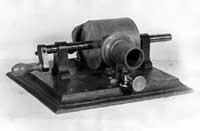
The Acoustic Era - Thomas Edison is generally credited with inventing the phonograph in 1877. Although others claimed to have invented it somewhat earlier, Edison was first to produce a working model and apply for a patent. The first phonograph (Phonograph was originally the trade name for the device) consisted of a rotating cylinder covered with tin foil. A recording was made by using a megaphone-looking horn or voice cone attached to a stylus or “needle.” Sounds captured by the horn caused the stylus to vibrate making impressions in the soft foil as it rotated. To play back the recording, the same stylus was placed in the grooves that had been created and as the cylinder rotated the vibrations were mechanically amplified by the horn.
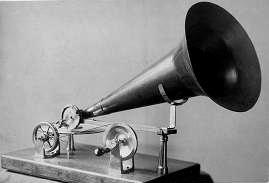
After patenting the phonograph, Edison allowed it to remain dormant, concentrating his efforts on inventing the light bulb, until competing devices began to come to the market. In 1887 Emile Berliner patented the Gramophone. The Gramophone (also originally a trade name) used a flat disc rather than a cylinder, and thus kicked off the first format war. Berliner called this audio disc a gramophone record, but in the US it was called a phonograph record.
An early improvement to the recording cylinder was made by Alexander Graham Bell and his brother. They replaced the tin foil on the cylinder with wax, thus creating the “wax cylinder.” One of the early problems with cylinders was the difficulty of mass production. Cylinders were reproduced by re-recording the master cylinder onto additional cylinders. However, only about 25 cylinders could me made in this manner before the original cylinder became too worn to play. In order to get additional copies, the performers were required to repeat the performance multiple times, a rather time-consuming and expensive procedure. Finally in 1902 a method of mass producing the cylinders was developed significantly reducing the cost of cylinders.

Theoretically the audio quality of the cylinder should have been much better than that of the disc because of its constant linear groove speed and higher dynamic range, but in reality there was little noticeable difference. However, discs could be easily and cheaply mass-produced. A master disc was used to mold copies onto hard rubber discs. (Originally a disc was recorded on only one side. Later someone came up with the idea of recording on both sides, creating the “B” side or “flip” side.) Discs also had the advantage of being more easily stored, and several could be placed into a book to form an “album.” Discs eventually won the format war and within twenty years the cylinder had all but disappeared.
Whether using discs or cylinders, the recording process was the same. The performers would gather around and play into the horn recording directly to the disc or cylinder . Whether it was a soloist or a full orchestra, the procedure was the same. The only ability to “adjust the mix” was to move the performers closer or further from the horn. This method of recording was entirely mechanical and was called acoustical recording.
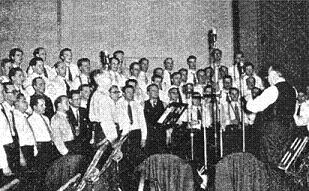
The Electric Era - Despite this rather crude method of recording, over the next two decades audio quality slowly improved producing less noise and improved fidelity. In 1925, the acoustic era came to an end and the electric era began. Instead of horn, a microphone was used to capture the sound, which was electrically amplified and used to drive a lathe to cut the grooves on the disc. This process resulted in a tremendous improvement in sound quality. All the major labels made the switch that year and almost everyone else within a few years. However, performances were still recorded directly to the disc.
The electric process improved flexibility. While initially orchestras were recorded using just one microphone, engineers soon began using multiple mics. With the introduction of the mixer, the engineer now had a greater control of sound and could blend voices and instrumentation. There was still no editing capabilities. So if a performer made a mistake or the sound was not right, they started over from the beginning with a new disc.
The Tape Era - Work on magnetic recorders began in the early 1900s, beginning first with wire recorders. These machines used very thin steel wire that was magnetized as it passed over a recording head. Wire recorders suffered from poor sound quality, heavy reels, and difficult-to-handle wire. They were eventually replaced by magnetic tape, strips of plastic coated with finely powdered iron (which was later replaced with powdered iron oxide). It was not until the mid 1940s that the quality of tape recorders rivaled or surpassed that of disc recorders.
Hearing a demonstration of a tape recorder in 1944, Bing Crosby was astounded by the sound quality. He also saw the great potential of this new medium. At that time almost all music on the radio was performed live. Within two years Crosby convinced the network to allow him to pre-record his radio show using magnetic tape. He also became the first recording star to master commercial recordings on tape.
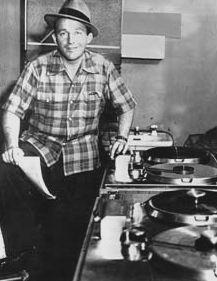
Crosby was so impressed with the process that he invested $50,000 in the Ampex Electric and Manufacturing Company (which later became the Ampex Corporation), the main force in early commercial tape recording. With this infusion of capital, Ampex developed a two-track recorder within a few years and eventually three- and four-track machines.
Tape recorders in the recording studio introduced innovations that drastically changed the way music was made. Among other things for the first time a musical performance could be edited. The engineer could cut and paste—literally snip a piece of tape from one portion of the performance and insert it in at another. Tape made music making much more flexible. Now it was easy to trim extraneous sounds, mix sounds from more than one source, and fade music in and out. Whereas in the past a performer would have to record a song multiple times until he or she got a perfect take, now it was possible to splice together two imperfect takes to get one good one.
The next big advance in tape recording was multitracking. Four-track tape machines allowed the engineer to record different things on the various tracks. For example, he could record the vocal on one track, the drums on another track, and other instruments on other tracks. This procedure gave him the ability to mix the various tracks after the fact. Before all mixing was done on the fly. It also allowed for re-recording one track separately from the others. If for example the vocalist made an error during the take, he or she could just re-record the vocal track. The instrumentalist did not need to hang around.
Multitracking also led to many new innovations. In the early 1950s, Les Paul (who also is credited with developing the electric guitar) ordered the very first eight-track machine from Ampex and began experimenting. Paul was one of the first recording artists to record additional tracks after laying down the original tracks (a process that became known as overdubbing). He not only did this with his guitar, but he used this technique to allow the vocalist, his wife Mary Ford, to harmonize with herself.
The Beatles were particularly adept at taking advantage of multitracking. In the 1960s the 4-track recorder was the standard in many studios. The Beatles would make a recording using all four tracks. Then they would mix these tracks down onto one track of another machine. This process called bouncing down (or reduction mixing in the UK) opened up three additional tracks for them to use for overdubs and other experimentation. However, there was a limit to how many times this could be done because there was a build up of noise in the bounce-down process. It is a real tribute to the Beatles' skill and creativity when you realize what they were able to accomplish within the limits of 4-track recorders. Bouncing down essentially disappeared, as 16-track recorders became the standard. Later machines with 24 or more tracks became common, allowing for even greater flexibility in the recording studio. Instead of recording sections of a band or orchestra, multiple tracks allowed each individual instrument or performer to be recorded on each track.
While magnetic tape had many great advantages over direct-to-disc recordings, it suffered from one annoying problem—tape hiss. The problem was not all that noticeable at first, but beginning in the 1970s with advances in solid state electronics and improved speaker design, consumer equipment had improved to the point where hiss was becoming apparent. To combat this problem Dolby Laboratories developed a method to reduce tape noise. By boosting higher frequencies (the range in which hiss occurs) while recording and then reducing the level of those same frequencies during playback, the hiss was significantly reduced. Most consumers are familiar with Dolby B, which became the standard for cassette tapes, but Dolby A used a similar process that was used in recording studios. It greatly reduced the hiss problem, but did not eliminate it.
The Digital Era - Digital recording methods were introduced during the 1980s. Over the next decade digital recording gradually displaced analog tape. The real advances in digital recording took place in the early 1990s as the capacity of computer hard drives and computer CPU speeds increased significantly. Today almost all major recording studios have digital capabilities, although some still maintain magnetic tape recorders for certain situations. Digital recording completely eliminates the tape hiss problem.
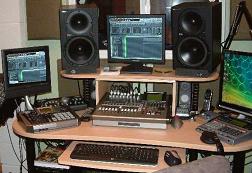
Just as magnetic tape introduced many innovations to the recording scene, the digital process also created new opportunities for creativity. Many of the special effects that previously were done with specialized equipment can now be done with software, contributing to improved sound quality. Each time the signal is passed through another piece of equipment there is an increased chance to introduce noise and distortion. Software-based effects are not as likely to cause such problems (although poorly designed software can adversely affect the sound.)
The digital process expanded some of the capabilities of tape multitracking. Multitracking allowed duets to be recorded by two artists at separate times. One artist would go into the studio and record his or her part. Then the second artist would go into the same studio days or weeks later and lay down his or her vocal track. Through the magic of mixing these two voices would be blended into a single duet. Using digital files this same process can be done, but instead of doing it in one studio, the master files can be emailed to another studio in another part of the country to lay down the second vocal track. In fact, many of the tracks on the duet albums by Frank Sinatra and Ray Charles were done in this manner. Some of the performers never met Sinatra or Charles in person.
One extreme example is the story of a lost tape by Hank Williams. When a previously unreleased copy of a demo sung by Hank Williams turned up in someone's attic, Hank Williams, Jr. went into the recording studio and recorded a vocal to accompany his father. The result was the hit duet “There's a Tear in My Beer” recorded more than 30 years after his father had passed away.
Editing has been greatly improved in the digital era. The cut and paste procedure from the tape era has become the computerized version of cut and paste. Miss a guitar riff? Re-record the muffed part and then copy and paste it where it's needed. Want verse 3 to become verse 2? Highlight it, copy it, and move it to where you want it. Just like moving words and paragraphs around using a word processor, similar things and more can be done with digital editing of musical tracks.
No one knows what new innovations will be coming down the pipeline over the next few years, but if the previous advances in recording techniques are any indication, things are going to be truly amazing.
If you have questions about the recording process, please contact us. For more information, please see:
Wikipedia: The History of Sound Recording
Vintage Audio History
The History of the Edison Cylinder Phonograph
Emile Berliner - The History of the Gramophone
Electrical Recordings
Mix Online: 20 Audio Innovations that Changed the (Pro Audio) World
________________________
Originally written in 2012
Last update: 02/10/2025
